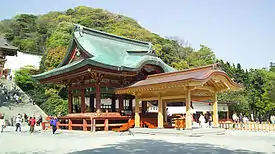
Tsurugaoka Hachiman-gū's kagura-den
The kagura-den (神楽殿, "kagura hall"), also called maidono (舞殿) or buden (舞殿) with reference to the bugaku traditional dance, is the building within a Shinto shrine where the sacred dance (kagura) and music are offered to the kami during ceremonies.[1] It was originally just a temporary stage; first mentioned in a 9th-century text describing a maidono built in front of Hirano Shrine. In about a century, it had become a permanent shrine feature, and its use was extended until its function as a worship hall prevailed over the original.[1] It is used also for weddings and Noh plays. Some scholars believe the heiden, or hall of worship, has its origins in the kagura-den.
References
Wikimedia Commons has media related to Kagura-den.
This article is issued from Wikipedia. The text is licensed under Creative Commons - Attribution - Sharealike. Additional terms may apply for the media files.